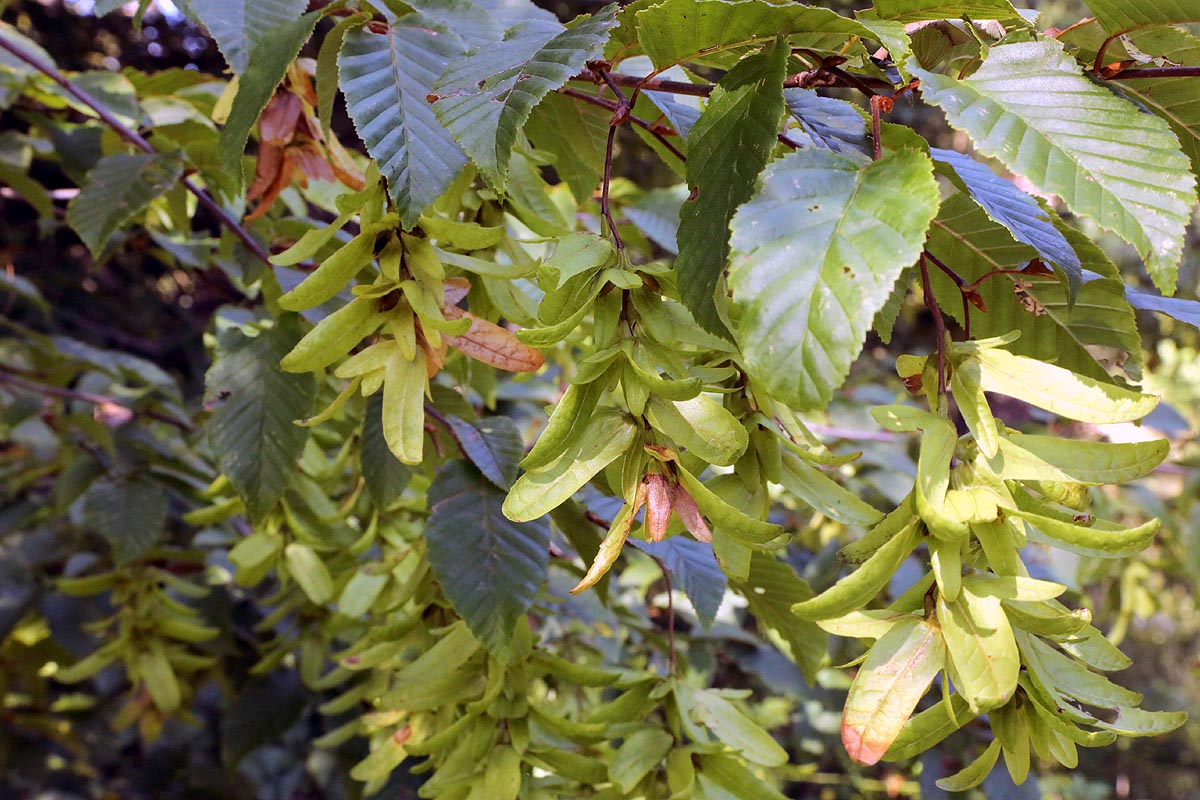A compact neat deciduous tree eventually reaching about 50 feet (15m) but slow growing. The name refers to the dense horn-like heavy wood that was once used to make beams and ox-yokes. Its a beautiful slow growing tough tree, hardy to zone 4 and fairly slow growing once out of its seedling stage. Deeply corrugated leaves give it a very attractive look along with the precise oval form that the tree takes making it look almost pruned. Ideal tree to stand alone in lines because of its neat shape. Drought tolerant when established, can make a good street tree. Not much troubled by pests and diseases but many butterflies and our large moths use it as a host plant for their young.
Its leaves are arranged alternately on the stem and dark green when mature. They are oval spear shaped fat at center with sharp point with double serration, meaning they have big serrations with smaller ones in between. The veins are deep giving the leaf an almost corrugated look which makes them very visually attractive
Tree has both male and female flowers known as catkins. The female ones are smaller up to 3 inches (7.6cm) long, greenish with longer wispy flyaway's. Male flowers are much larger up to 6 inches (15.2cm) and more numerous than the females and covering the tree in springtime just as the leaves are emerging. Flowers produce copious amounts of pollen as Hornbeams are wind pollinated.
Fruits (seeds) are small for a tree and located at the base of a large bract similar to a sycamore but hang in long clusters like holiday ornaments until they turn deep brown and dissipate in late autumn. The bark of a mature tree is slate grey with initially mild striations that become deeper with age.
Autumn (fall) ordered seeds can be sown directly in the ground in cold climates and allow the winter weather do the work for you. However we do not recommend this method as you have little control over the seed process and they are often eaten by wildlife.
We recommend controlled stratification, this can be done by sowing seeds in pots or trays and placing in a cold garage or shed or by using your refrigerator. See our stratification instructions for more details. A copy of these will be sent with seed orders.
Keep seeds in refrigerator until ready to plant. Seeds usually need about 60-90 days of moist stratification before they will germinate. Soaking them in water for 24 hours before planting can speed up germination process. Plant roughly 1/4 inch (0.5cm) deep.
Seedlings are slow to germinate. Planting in individual pots or tray cells ensures that no un-germinated seeds are disturbed when seedlings are transplanted. We recommend nursing in pots for the first year before planting out. Once germinated place pots in shaded area outside to begin with and gradually move to full sun to ensure plants have enough time to acclimatize to the sunshine. Immediate full sun can either kill or set a plant back badly. If seedlings grow well plant trees in fall of first year and protect with cages to ensure wildlife do not eat them. This is especially important if there are deer (elk or moose) present. Protect trees until they are large enough to withstand browsing. If trees remain in pots over the winter place them in a structure so that the pots do not freeze. Overwintering trees don't need much light so close to a window in an attached garage is ideal.
Location and Care of European hornbeam (Carpinus betulus).
Hardy to zone 5 and in more sheltered locations to zone 4. For zones 4-7 full sun is the best location. Use as an accent tree alone so they precise shape can be seen and admired. In locations below zone 7 light shade is best as being a northern European tree it does not do as well in hot areas so a little shade from heat and full sun produces best results. Give it plenty of room to grow and expand the center of a lawn or as an focus point tree or line of trees in larger open areas is the most advantageous and attractive option for these trees. Once established they are fairly drought tolerant. Not really fussy about soil type but does not like wet soils, well drained is best. Makes a good street tree due to its compact form and slower to grow if roots and water are restricted by too much impermeable surface.
Pests And Diseases of European hornbeam (Carpinus betulus).
Its pretty resistant to most disease problems including cankers, leaf spots, blight and wilt. Insects are the main problem, some are good like the butterflies and moths, but others like the Japanese beetles can devastate the leaf coverage of the tree especially in the south eastern states. Birds will eat the bugs from the trees in spring, so it is recommended that young trees be protected to prevent this until they are large and strong enough to accept some bud loss. If all the buds are eaten from a young tree it could die.
Uses of European hornbeam (Carpinus betulus).
Hornbeam wood can be coveted. It is often described as hard, tough and heavy so it was used for items like cart axils, ox-yokes, wheel spokes, tool handles, butchers blocks and house beams. While the requirements for some of these items is now reduced the wood is still in high demand. It is often used to make pianos and wooden screws for use in antique and period furniture.








